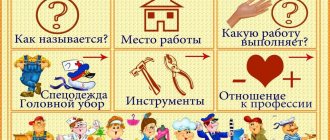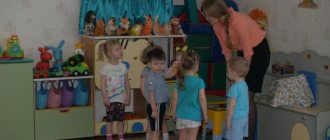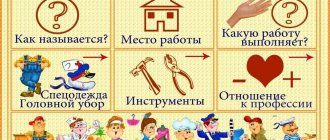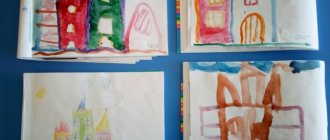Lesson - questions on the topic “Professions”
Lesson 4. Name the items needed for the profession:
- Programmer... (computer) - Astronomer... (spyglass) - Accountant... (calculator) - Geologist... (backpack) - Journalist... (recorder, pen and notepad) - Engineer...( drawing)
Lesson 5. Name the extra item:
- dough, baking dish, candy, bread (Baker) - needle, fabric, paper, scissors (Tailor) - stage, makeup, camera, flippers (Artist) - notes, stick, music, pen... (Conductor)
Lesson 6. Who drives what:
- drives a rocket - drives a train - drives a plane - drives a ship - drives a car - drives a tram, trolleybus, bus - drives a crane - drives an excavator - drives a tractor - drives a motorcycle
Lesson 7. True-false.
- a cleaner, who creates hats - a gardener works in a kindergarten - a carpenter sits at a table - a driver, who drives to different places - a cyclist, who steals bicycles - a blacksmith, who catches grasshoppers.
Lesson 8. Women's profession:
- boss... (boss) - artist-... - weaver... - translator... - waiter... - makeup artist...
Lesson 9. Who does what:
- works as a welder - carries luggage at stations - repairs watches - writes music - writes poetry - plays the piano
Exercise 10. Tell us about your parents’ profession.
On the topic: methodological developments, presentations and notes
Summary of an open event on the implementation of educational areas: “Labor”, “Cognition”, “Artistic creativity”, “Music” on the topic: “All professions are needed, all professions are important” in the senior group.
Goal: expand and enrich children’s ideas about professions.
Getting to know your surroundings. Middle group.
Abstract of GCD on manual labor in the senior group Educator: Brodnikova Lyubov Vladimirovna Topic: “All professions are important - all professions are needed.” Areas of integration: knowledge, fiction, art.
To form in children a generalized concept of “profession” through conversation, games, and assignments.
Source
Abstract of GCD for drawing on the topic “Adult Labor”
Fatimet Yahutl
Abstract of GCD for drawing on the topic “Adult Labor”
Abstract of GCD on aesthetic development. Drawing .
Topic: " Adult Labor "
.
Expand your understanding of professions. Introduces the profession of a janitor.
Cultivate a desire to provide assistance and pay attention to those in need. Enrich cognitive knowledge (familiarity with tools, objects of work of a janitor )
.
Generalize knowledge about the required professions. Show the importance of the janitor profession, cultivate a respectful attitude towards working .
Materials: broom, broom, paints, album sheets, jars of water, brushes.
An example of a drawing lesson summary on the topic “Professions”
The main purpose of such a summary is to teach children plot drawing. To do this, you need to depict people in motion and create interesting compositions.
Note! An equally important factor is the development of compositional skills (draw across an entire sheet of paper, convey proportional and spatial relationships between objects)
Lesson Objectives
Main objectives of the lesson:
- form ideas about the activities of a particular profession, tools;
- to instill in children a sense of appreciation and respect for the work of adults;
- continue to introduce children to dangerous objects for the sake of life and health safety;
- replenish children's vocabulary;
- consolidate the names of familiar professions, as well as objects and tools.
Creative corner
Developmental tasks:
develop the ability to construct complete answers, listen carefully (communication); develop memory, attention, logical thinking (cognition); develop initiative, the ability to act in a team (socialization).
Step-by-step drawing for beginners - lessons for children
Educational tasks:
- develop respect for people of different professions;
- cultivate feelings of responsiveness and mutual assistance.
Summary of a drawing lesson in the middle group. Theme "Professions".
Elena Bulgakova
Summary of a drawing lesson in the middle group. Theme "Professions".
Summary of a drawing lesson in the middle group. Theme "Professions".
Goal: Expand children's understanding of the visual possibilities of paints. Strengthen the ability to name primary colors, learn to select the right color when creating a certain image. Cultivate compassion and kindness.
Material. An uncolored rooster drawn and cut out of paper. Landscape sheet with a drawn silhouette of a rooster, red, yellow, blue and green gouache, brushes, jars of water, rags (for each child).
Preliminary work: Introduce children to V. Suteev’s fairy tale “The Rooster and the Paints.”
Progress of the lesson
Educator:
— Children, today an unusual guest came to our garden. Do you want to meet him?
Children's answers.
Educator: Shows an unpainted rooster and says on his behalf:
“Everyone laughs at me, they say that I am not painted, that I am not real. They told me to go to the artists. They have some paints they can use to paint me.”
Educator: Children, what is on my table?
Children's answers. Paints.
Educator: What are they called? What color are they?
Children's answers: Gouache paints. Red, blue, yellow and green. - And
Educator: Well done! Oh, you can draw with them.
Children's answers: Sun, grass, apple, tomato, sky.
Educator: Correct. With their help, you can paint any object, and it will turn from unpainted into a real, beautiful one.
The teacher asks the children on behalf of the rooster: “Can you guys color me?”
Children's answers: Yes.
Educator: “Of course we can, today we are artists and we have paints. Look how we will make you a real rooster: we will paint the comb and beard with red paint (as we explain, paint the carved rooster, blue paint the feathers on the tail, green paint the wings, and yellow paint the breast... What a beautiful rooster it turned out to be."
The teacher gives the children album sheets with silhouettes of roosters and offers to help the roosters - color them - using all four colors in their work.
These are the roosters that my children and I got
Summary of the integrated GCD “All professions are important, all professions are needed” in the middle group GCD topic: “All professions are important, all professions are needed.” Direction of education and development (educational field): cognitive development(.
Summary of direct educational activities in drawing in the middle group. Topic: “Boots for a centipede” Program content: teach children to draw straight lines from left to right, circles consisting of two semicircles, dots (draw with cotton swabs);
Notes on non-traditional drawing with wool in the middle group. Topic: “Masha’s Adventures” Summary of direct educational activities on non-traditional drawing in the middle group “Masha’s Adventures”. The goal is acquaintance.
Lesson summary for the middle group on introducing adults to labor. Topic: “Important professions.” Goal: To teach and generalize children’s knowledge about the work of a doctor and some of his work actions. Expand your vocabulary with medical terminologies.
Summary of a drawing lesson in the younger group. Topic: “Miracle Snowdrop.” The lesson outline is designed for two lessons: the first is aimed at cognitive development, the second at artistic and aesthetic development. Summary of a drawing lesson in the younger group. Topic: “Bullfinches and titmice.” Educational field: “Artistic and aesthetic development”, “Cognitive development”. Objectives: 1. Strengthen drawing skills.
Summary of a drawing lesson in the middle group Topic: “Shoe in a puddle” Purpose: To teach children to cut out double silhouettes of paired objects, accurately convey the shape and give it additional expressive features.
Summary of a drawing lesson in the middle group. Topic: “Autumn Harvest.” spruce: Learn to depict objects using non-traditional drawing techniques. Develop children's sense of composition and color. Tasks:.
Copy of GCD in the educational field “Cognition” (FCCM) in the middle group. Topic “Professions” Abstract of the educational activity in the educational field “Cognition” (FCCM) in the middle group. Topic “Professions” Integration of educational areas: communication,.
Source
Riddles on the theme “Professions”
He corrects mistakes, He reflects with us. Teaches us to write, read, What to call our profession? (Teacher)
The cabin is like a home to him, He is familiar with the roads. The traffic light flashes for him, And says that he... (Chauffeur)
The one who rushes in a car with blue flashing lights, who extinguishes the fire with water, pouring hoses. (Firemen)
A man stands guarding the law. Nice uniform on him, pistol in a holster. (Police officer)
On Earth we have various disturbances, hurricanes, explosions, storms and earthquakes. We didn’t waste time, the Ministry of Emergency Situations... (Rescuers)
He is not afraid of flying, he flies planes in the sky. At the helm all year round, By profession... (Pilot)
You went to the circus with your family and laughed heartily. The hall is full of delight, Because he came out... (Clown)
Knows all the laws, constantly performs. And he is not an Artist at all, His profession is... (Lawyer)
The dining room menu for lunch includes cutlets, soup and vinaigrette. The guys eat, don’t argue, because the best cooks... (Cook)
Goes on a flight, But not a pilot, not a pilot. He will land on the planet, He is in a big, big rocket. (Astronaut)
He guards the border, the borders of our country. So that the enemy cannot break through, so that there is no trouble. (Border Guard)
When he was studying, he was a cadet, He was taught to fight, to defend his native country. Now the shoulder straps are on his shoulders, and he holds the rank of lieutenant. (An officer)
We receive a letter, Who brings it to us? (Postman)
Whoever is sick, He will help and heal. A man in a white robe is busy with a very important matter. (Doctor)
The children were brought to kindergarten, and the parents left. You kids shouldn’t have cried, they love you... (Teachers)
If we need books, We go to the temple of silence. You can learn a lot if you like to read. Well, to discover a magical way, Help us... (Librarian)
He boldly wields scissors skillfully, To keep your hair in order, He will style your hair. And with the help of a comb, a good hairstyle. (Hairdresser)
Practical part of the lesson, drawing a profession
In order for the drawing of a profession to be useful in the older group, and for the children to find it interesting, the teacher needs to adhere to a certain course.
First, he needs to find poems that are dedicated to professions and drawing. At the end, the teacher needs to ask the children a question: What professions can you name? At the same time, they should not name items that have already been previously voiced in the poem. Next you need to organize a simple game. The teacher takes the ball, throws it, the one who catches it guesses a riddle related to human activity. Or you can show children pictures so that they visually understand who the profession is in the picture. Finally, the teacher must praise the children. The third stage will be the actual drawing. The teacher once again shows pictures of people so that the children can understand what they look like, how their torso and arms are located
It is necessary that the teacher draw the children’s attention to all the details depicted.
The guys start drawing, the teacher does not forget to observe and help those who ask for help.
Drawing steps:
- the teacher explains how to draw the foreground and background;
- what colors may predominate in a particular profession;
- shows the technique of drawing people;
- Based on all that has been said, he invites the guys to try to draw themselves in the profession in which they see themselves.
This same technique can also be used in a drawing lesson, but also in a preparatory group on the topic of Professions in kindergarten.
To make drawing more fun for the children, you can turn on music quietly in the background, or the teacher can sing a few songs dedicated to this topic.
Joint activities will also help parents and parents get even closer, learn to interact and understand each other.
An example of a drawing lesson summary on the topic “Professions”
The main purpose of such a summary is to teach children plot drawing. To do this, you need to depict people in motion and create interesting compositions.
Note! An equally important factor is the development of compositional skills (draw across an entire sheet of paper, convey proportional and spatial relationships between objects)
Lesson Objectives
Main objectives of the lesson:
- form ideas about the activities of a particular profession, tools;
- to instill in children a sense of appreciation and respect for the work of adults;
- continue to introduce children to dangerous objects for the sake of life and health safety;
- replenish children's vocabulary;
- consolidate the names of familiar professions, as well as objects and tools.
Creative corner
Developmental tasks:
develop the ability to construct complete answers, listen carefully (communication); develop memory, attention, logical thinking (cognition); develop initiative, the ability to act in a team (socialization).
Exercises for developing memory in children in kindergarten classes
Educational tasks:
- develop respect for people of different professions;
- cultivate feelings of responsiveness and mutual assistance.
Summary of GCD in the preparatory group on the topic Professions
Summary of GCD in the preparatory group
Abstract of educational activities for children of the preparatory group (6-7 years old) on the topic “Different types of profession”
Integration of educational areas “Cognition”, “Communication”, “Artistic creativity”, “Physical education”. Goal: expanding children's knowledge about the variety of professions. Objectives: to consolidate children’s knowledge about different types of profession, to show that people of different professions are closely connected with each other and do one common thing together; introduce the creative profession of an artist; develop children's speech, expand their vocabulary of words: landscape, still life, portrait; cultivate interest and respect for people of different professions. GCD progress: - Have you ever thought about the fact that all adults have one profession or another and work every day? — How do you understand the word “profession”? Right. This is the main occupation, work activity to which a person devotes his life. - Let's remember what professions there are. Right. Educator, teacher, doctor, salesman, driver, builder, policeman. There are many professions! Who will give the book? Librarian. Who bakes bread in the bakery? Baker. The letter will be delivered by the postman, and the cook will cook us some broth. The teacher will teach you everything - teach you how to count and write. There are many professions, you can’t count them all in poetry! To master any profession, you need to develop certain character traits. Many professions require a person to be able to communicate, listen carefully to people, maintain a friendly and friendly tone, and show kindness and responsiveness. — Try to name professions that require a person to show courage, the ability to instantly assess the situation and make the right decision. Policeman, rescuer, firefighter. — Tell me, what unites them? (ability to communicate, listen carefully to people, maintain a friendly and friendly tone, show kindness, responsiveness, patience)
.
— Tell me, what would you like to become when you grow up? I think when you grow up, you will find something you like! — There are also creative professions. To become an artist, writer, artist, musician, you need to have talent and a good imagination. — Today we will talk about people who have an amazing ability to draw. Such people are called artists. This is a very important profession, artists draw pictures, depict what they see and introduce us. With what we don’t notice, Elastic plantain, And Ivan’s brushes of tea, And the blue of the river, And the golden field, All the beauty of the earth. The artist will reveal it to us! - Tell me, you like to draw! — What do you draw with and on what? Our distant ancestors also loved to draw. Although they had no paper, no canvas, no pencils. Stone Age people painted their designs on the smooth surfaces of large stones and rocks. With amazing accuracy and expressiveness they depicted wild animals: deer, wild boars, mammoths, as well as hunting scenes. They carved their drawings with stone teeth and axes, sometimes using natural paints - the juices of some plants. The creations of these artists have survived to this day and are stored in museums. We can safely say that art came to us from ancient times and was born along with man. People at all times wanted to reflect in drawings the most vivid impressions of life, to depict the world around them. — Tell me, what else can you use to draw besides pencils and felt-tip pens? (paints, gouache, crayons)
.
Most often, artists depict their native nature in their paintings: meadows, fields, rivers, rainbows - such paintings are called “Landscapes”. Pencil, pencil! Draw me a landscape. Stroke after stroke - the result is an old house, a front garden and a porch, and in the distance - meadows and a river. Admire the landscape, Do you recognize our village? - I think many of you have seen the painting “The Rooks Have Arrived” by A.K. Savrasova, “Birch Grove” by A.I. Kuindzhi. (look at the paintings)
- Have you tried the delicious sweets “Teddy Bear”?
Don't be surprised, because we're talking about artists? The candy wrappers depict a mother bear with her cubs. This is a reproduction from a painting by the wonderful artist I.I. Shishkin "Morning in a pine forest." — What do you think portrait artists depict on their canvases? (portraits of people)
. - Look, artists not only draw people, but also try to convey the appearance of a person, reveal his character, show his mood. I have a pencil, a piece of paper and gouache. I will draw a portrait of Little Alenka: Jacket, scarf and beret With a blue pompom. I will draw a forehead and nose, a strand of fluffy hair, long eyelashes. What
Perhaps I managed to achieve the resemblance!
Physical Education Minute Also on their canvases, artists depict household items: fruits, vegetables, showing us their beauty - such a picture is called “Still Life”. I will beautifully arrange a bunch of grapes, pears, and plums on a saucer. I'll open my notebook and start drawing fruits. First, I’ll draw plums with a lilac-pink tint. Then a fragrant pear side, in which ripe juice ferments, then transparent grapes, preserving the southern aroma. The still life turned out successful, and I’m proud of my drawing! — Do you like looking at bright, elegant picture books? - Why do you like them? Artists who decorate children's books with illustrations are called “Illustrators.” - Let us also be artists today. Go to the table and take the material that you will need for your work. - Think about what you want to draw? “Still Life”, “Portrait”, “Landscape”. When you finish your work, we will arrange an exhibition of your works, and you will tell us what you drew. At the end of our lesson, I want to give you all colored pencils so that your drawings will always be bright and colorful and will please not only you, but also all the people around you.
We recommend watching:
Summary of the GCD for FEMP in the preparatory group Traveling around the country Mathematics Summary of the GCD for the preparatory group on the topic “Paintings by artists” Summary of a recreational and educational lesson on traffic rules in the preparatory group Synopsis of the GCD for FEMP in the preparatory group on the topic “Visiting Professor Aquarius”
Similar articles:
Summary of educational activities on cognitive and speech development in a speech therapy group preparatory to school
Summary of educational activities on cognitive and speech development for a speech therapy group preparatory to school
Summary of GCD with elements of non-traditional types of gymnastics in the preparatory group for the educational field “Physical Education”
Outline of GCD in the preparatory group
Summary of educational activities on cognitive development in the preparatory group
Fine arts lesson on the topic “Professions” in the middle group of kindergarten
To begin with, the teacher selects the appropriate game, for example, “Determine a person’s profession.” Its main goal is to teach how to distinguish between people’s positions based on their special clothing.
Fine arts lesson on the topic “Professions” for children of the middle group
Note! The teacher should ask the children what kind of clothing is needed for a cook, a policeman, a sailor, or a salesman. The game is played with items of clothing
When considering several professions at once, it is advisable to use coloring books to make it easier for children to learn the material. They will color people in different clothes. At the end of the lesson, the middle group children, as a rule, show each other their pictures. These actions are carried out to:
- expand and clarify children’s ideas about the work of people of different callings;
- teach kids to identify the names of professions based on the actions depicted;
- develop spatial representations: left, right, up, down, behind, in front;
- teach children to count a given number of objects and compare their totality;
- compare objects by height;
- consolidate knowledge about geometric shapes, vegetables or fruits;
- develop the ability to complete sentences using words and phrases related to a person’s specific profession;
- use new words: hairdresser, builder, driver, salesman, painter, cook, doctor;
- strengthen the ability to draw and paint with colored pencils;
- develop curiosity;
- cultivate respect for people, their activities, and their results.
Summary of drawing lesson “My dream profession”
Summary of drawing lesson “My dream profession”
Goal: To form children’s ideas about professions. To develop children's interest in the work of adults (including parents). To promote in children the ability to convey in a drawing the image of a working person, depicting figures of people in characteristic professional clothing in a working environment
Objectives: Continue to develop children’s knowledge about professions. Exercise the ability to independently choose art materials in accordance with the plan, develop children’s drawing skills; Activate children's vocabulary, develop the ability to answer questions; develop fine motor skills and coordination of movements;
Children and their teacher stand in a circle.
All the children gathered in a circle,
I am your friend and you are my friend.
Let's hold hands together
And let's smile at each other!
(Hold hands and look at each other with a smile).
Educator: Guys, when I came to work, I found an envelope on my desk. Let's open it and see what's inside (there are pictures with types of professions inside). How can you say in one word? These are professions (children's answers).
Educator: That's right. All adults on our planet work. And your mothers and fathers also work at their jobs. Diana where does your mother work? Where does your mother work, Polina (children’s answers)
Questions for children based on the drawings they have drawn on the topic “Professions”
At the end of the lesson, the teacher can ask the children several thematic questions:
- What profession did you draw?
- What are the features of your chosen profession?
- Why did you choose this particular activity? Why do you like her?
- What will you do in this position?
Note! Questions can be replaced with riddles or proverbs and sayings about work. After asking questions, the teacher must say that the children did a good job, drew excellent pictures, and that they gained a lot of new knowledge and skills throughout the lesson.
After asking questions, the teacher must say that the children did a good job, drew excellent pictures, and that they gained a lot of new knowledge and skills throughout the lesson.
The final version of the drawing respecting the composition
All consistent outline plans should help children not only learn to draw and maintain composition, but also learn more about professions, their characteristics, that every work is worthy of respect and that there is no bad work.
Note! Leading questions, riddles, fairy tales, proverbs and sayings will help consolidate their knowledge. Lessons can be diversified with small theatrical performances that will help children better see the profession, and then, in fact, draw it on paper
Lessons can be diversified with small theatrical performances that will help children better see the profession, and then, in fact, draw it on paper.
The teacher should help children: develop their abilities, have conversations, and also more often organize creative drawing classes dedicated to a particular topic, since the Federal State Educational Standards system of preschool educational institutions is aimed at ensuring that a preschooler receives a sufficient amount of knowledge and skills before going to first grade.
Lesson notes for the middle group “Who is an artist?”
What feelings does the painting evoke?
Are you happy or sad looking at her?
What is the most important thing in the picture?
Describe the children's faces.
What did the artist V. Perov want to say with his work?
Educator:
Let us create our own work too! Let's think about what will be the main thing and how we can arrange the remaining objects so that we get a real picture. (The teacher conducts the didactic game “Make a Picture”)
Educator: Guys, do you think it’s difficult to be an artist? (Children's answers).
Educator:
Yes, to create their works, artists travel a lot, observe, and fantasize. Only then do they draw what they especially liked. Very often the artist does not have time for rest and entertainment. But you and I know that you need to take care of your health. If you are tired, you need to rest a little. I suggest doing exercises.
Physical education minute
I have always dreamed of becoming an artist, the gesture of dreaming, resting my head on my hand.
That's why I drew everywhere. Drawing in the air with an outstretched hand
.
With a pen on a piece of paper like this Drawing in the air with your hand, at chest level.
With a brush on the canvas like this Drawing in the air with your hand extended forward.
Pencil on the desk Drawing in the air with your hand, at chest level.
And chalk on the asphalt. Drawing in the air with your hand, at floor level
.
Boots on the snow, Foot drawing on the floor.
I skate on the ice with skates. Drawing on the floor with your foot.
On the sand with a twig, Drawing in the air with an imaginary twig on the floor.
On the board with a nail. Drawing in the air with an imaginary nail.
Educator:
To make the painting truly beautiful, the artist, like a real wizard, selects colors and mixes them. Let us also try to mix paints and get new shades. But we will do this not on a palette, but in magic jars. (The teacher conducts an experiment “Mixing colors”).
Educator:
But to paint a picture, the ability to mix paints is not enough. An artist must be able to peer into the world around him, listen in order to notice everything and draw beautifully. Then the lines, dots and spots will create real magic. See what can come out of ordinary lines, dots and spots. (The teacher shows and explains drawing from a spot, line, point).
Educator:
And now I will touch each of you with my brush and turn you into real artists. (The teacher touches each child with a brush, calling his name).
Educator:
Now, like real artists, you can draw your own miracles. Take your materials and turn the shapes on your sheets into something fabulous and unusual. And when you finish your work, we will all try to guess what you did together. (Music plays. Children draw on their own, the teacher helps children who have difficulties with guiding questions.).
Progress of the lesson.
V.: - Guys, look how warm it is outside. Let's hold hands and transfer our warmth to each other. Well done! (Children hold hands and form a circle.)
IN
: Attention! Let's get ready to work! (Children should stand in a circle, facing the teacher). IN
:Look around and say:What time of year is it now? (spring)
V.: Look around and say: What time of year is it now? (spring)
. After what time of year does spring come? (after winter)
. Winter is over, spring has come, and everything around has changed. How has the area changed since spring arrived? (The snow has melted, puddles have appeared, the trees are coming to life, leaves will soon appear, the sky is blue, clear, the sun is shining brightly, it’s warm outside)
Do you want to take a walk on the property? (YES)
. Why? (It’s warm outside, the sun is shining brightly, the area is clean and beautiful)
.Guys, early this morning, when I was going to work, I saw this object on our territory.
What do you think this is? (broom)
Guess who we'll be talking about today? (About the janitor)
He will wake up at dawn
The snow will be cleared in the yard.
All paths will be swept
And the ice will sprinkle sand.







